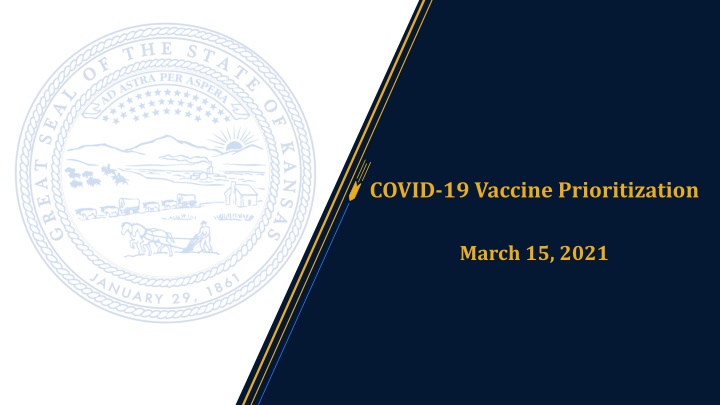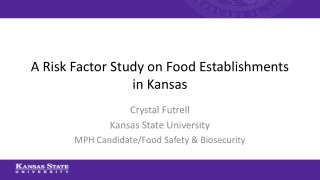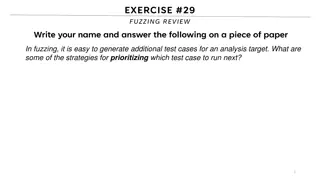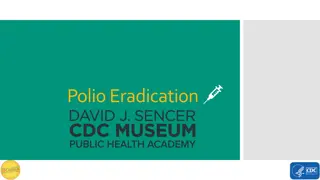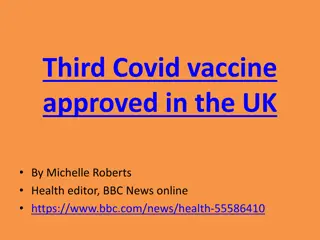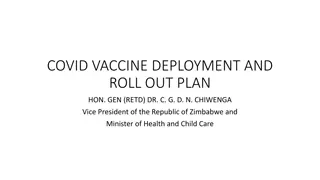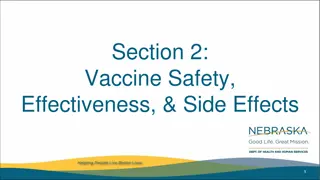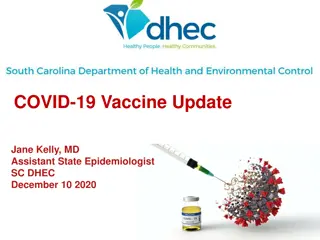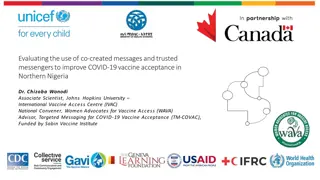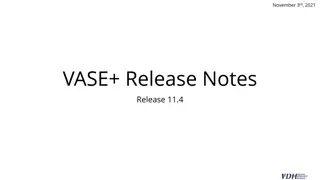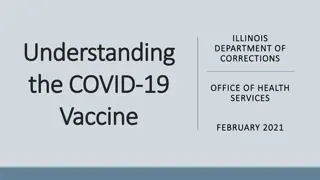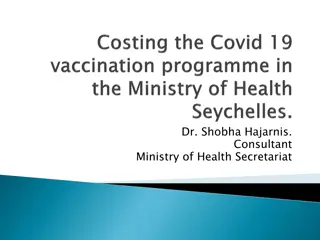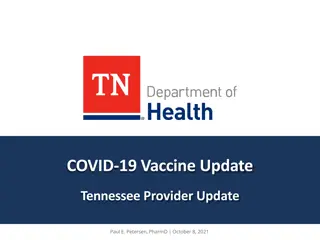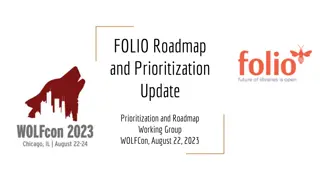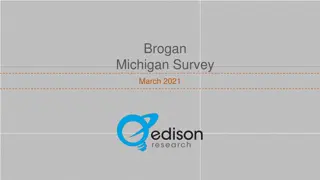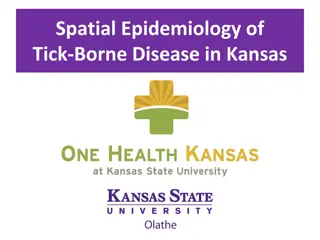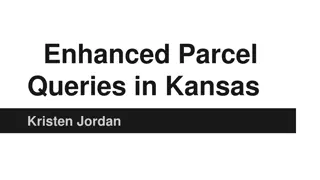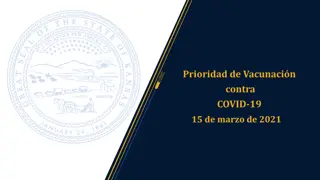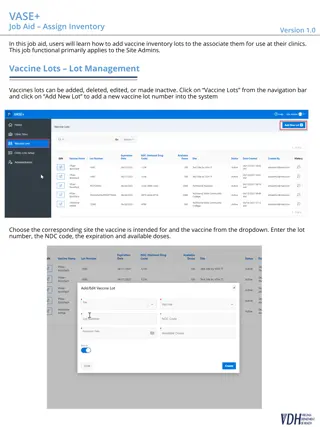Kansas COVID-19 Vaccine Prioritization Plan and Phases
The Kansas Department of Health and Environment (KDHE) has developed a prioritized vaccination plan divided into five phases to ensure equitable distribution of COVID-19 vaccines. The plan focuses on populations such as healthcare workers, individuals with severe medical risks, aged 16-64 with other medical risks, individuals aged 65+, and various critical worker categories. KDHE aims to adapt the phases based on evolving COVID-19 situations and maximize vaccination speed under federal supply constraints while maintaining equity in distribution. Local health departments and providers across Kansas are engaged in the vaccination process to reach vulnerable communities effectively.
Download Presentation

Please find below an Image/Link to download the presentation.
The content on the website is provided AS IS for your information and personal use only. It may not be sold, licensed, or shared on other websites without obtaining consent from the author.If you encounter any issues during the download, it is possible that the publisher has removed the file from their server.
You are allowed to download the files provided on this website for personal or commercial use, subject to the condition that they are used lawfully. All files are the property of their respective owners.
The content on the website is provided AS IS for your information and personal use only. It may not be sold, licensed, or shared on other websites without obtaining consent from the author.
E N D
Presentation Transcript
COVID-19 Vaccine Prioritization March 15, 2021
About this document As COVID-19 vaccines are approved by the FDA, the federal government is supplying states with limited doses on a weekly basis. Kansas Department of Health and Environment (KDHE) has created a list of populations, spread across 5 phases, to prioritize for vaccination This document lays out Kansas' current prioritized vaccination plan and provides more detailed definitions of identified population segments Our methodology To develop this phasing, we segmented and prioritized Kansas' population based on public health risk and criticality to state infrastructure Throughout the process, we have used an equity lens to ensure inclusion of socially and medically vulnerable communities our prioritization The Governor and KDHE engaged an independent advisory committee to review and co-develop these phases, ensuring input broad input We have also relied on the expert opinion of the CDC and ACIP recommendations The COVID-19 environment is dynamic, and thus we will continue to adapt these phases and priority groups as we learn more about the disease situation in Kansas and across the country COVID-19 vaccination phases in Kansas How we will operationalize these phases KDHE will maintain a flexible approach to moving through phases, prioritizing the vaccination of current phase populations and maximizing speed under federal supply constraints We are engaging local health departments, providers (hospitals, clinics, pharmacies) etc. across the state to distribute and administer the vaccine We will ensure equity throughout the vaccine distribution process, e.g. by prioritizing providers, such as safety net clinics in vulnerable communities and proactive outreach and communications to those all those communities at risk 1
Kansas Vaccination Phases | By Population Phase 1 Healthcare workers 2 3 severe medical risks 4 Aged 16-64 with other medical risks 5 Rest of pop. 16+ Aged 16-64 with Persons Aged 65+ Population Congregate settings Children* Residents or patients in Long- term care (LTC), senior housing or LTC-supported independent living Other critical workers All unvaccinated persons prioritized in previous phases High-contact critical workers All unvaccinated persons prioritized in previous phases All unvaccinated persons prioritized in previous phases All unvaccinated persons prioritized in previous phases Workers critical to pandemic response continuity Late January March Phases 3 & 4 May 2 *Subject to further research on Vaccine risks and effectiveness for children; Note: Dates of phases are dependent upon vaccine supply.
Federal guidelines1 consider the number and nature of contacts required by different occupations In addition to health risks associated with clinical outcomes and death, KDHE considered the following exposure-related risks in our approach Residents and staff are less than 6ft away from one another Proximity KDHE adopted federal recommendations to assess exposure risks associated with workplaces and living arrangements Exposure to droplets, shared surfaces, common items Type of contact Contact duration Average interactions last more than 10 min Challenges to implement protective measures Space is indoors, confined, or it is not possible to control with whom workers will interact 1. See DHS, Guidance on the Essential Critical Infrastructure Workforce: Ensuring Community and National Resilience in COVID-19 Response and CDC guidelines for those living in close quarters, shelters, nursing homes and on how the coronavirus spreads 3
Phase 1 | Healthcare workers: Identifying characteristics and working definition Paid and unpaid persons serving in healthcare or healthcare-associated jobs, who are unable to work from home and may be directly or indirectly exposed to patients or infectious materials as a result of their jobs Definition Workers with any of the following features: Required to regularly enter a hospital (inpatient) or outpatient clinical setting; Involved in pandemic response (e.g., testing centers); In a healthcare or healthcare-associated setting, in contact with patients or infectious materials; Description Staff in long-term care facility Workers in direct contact with patients, e.g., MD/DO/DPM, nurses, EMTs, clinical students and trainees Diagnostic labs, phlebotomists, pandemic health workers (e.g., individuals performing COVID tests) Mental healthcare providers, pharmacy staff, non-medical staff if exposed to patients or infectious materials; Healthcare-associated contractors, including food, waste management etc. Dentists, physical therapists, professionals performing elective procedures Home care workers, CMS-designated caretaker Morticians, forensic and funeral service workers; Staff in FQHCs, CHCs, safety-net/ free clinics, faith-based outreach clinics (inclusive of state-funded clinics) Home health aides, nursing assistants Examples of groups included 4 Sources: DHS CISA; The Advisory Committee on Immunization Practices Updated Interim Recommendation for Allocation of COVID-19 Vaccine,United States, December 2020
Phase 2 | High-contact critical1 workers: identifying characteristics and working definition Workers providing critical services who are at a higher risk of being infected, because their jobs require consistent and close contact with a large number of individuals Definition Critical workers are those necessary to maintain systems, assets and activities that are vital to the state (or national) security, the economy, or public health, as defined by the Department of Homeland Security Risk is associated with the likelihood of infecting oneself or spreading COVID. Factors that increase risk include proximity, type of contact, duration of contacts and challenges to implement protective measures Settings that provide a critical service and have recorded high transmission rates or become clusters in the past are usually high risk; Description Firefighters, police officers, first responders, correction officers Grocery store workers and food services K-12 and childcare workers, including teachers, custodians, drivers and other staff Food processing, including meat processing plants Large-scale aviation manufacturing plants Transportation workers Workers in the following industries, if they regularly need to be in high-risk settings to perform their duties: Retail, warehouses and sales outlets Agriculture Supply of critical services or materials for the COVID response (e.g. PPE) The U.S. Postal Service Department of Motor Vehicles Examples of groups included 5 1- As defined by the Department of Homeland Security Sources: DHS CISA; The Advisory Committee on Immunization Practices Updated Interim Recommendation for Allocation of COVID-19 Vaccine,United States, December 2020
Phase 2 | Congregate settings: identifying characteristics and working definition Definition Anyone living or working in licensed congregate settings and other special care or congregate environments Licensed congregate settings are facilities licensed by the state or local government, that provide housing or care arrangements and where social distancing is not possible; they provide a form of social service or healthcare (or healthcare-associated) service Settings included in this phase are monitored by the state or the local government, or house vulnerable populations under care, e.g. in-home care and retirement facilities Risk is increased because of: Proximity, i.e., residents and staff are less than 6ft away from one another Type of contact, i.e., exposure to droplets, shared surfaces, common items Duration, i.e., average interactions last more than 10 min Potentially high number of contacts and, sometimes, difficulties to implement protective measures Homeless shelters and other homeless housing settings and dwelling places Congregate childcare institutions, adult and child protective services Emergency shelters or safe houses for victims of domestic violence Corrections facilities, including jails and juvenile justice facilities Behavioral Health institutions (including mental health institutions) and residential treatment centers Adult care homes, residents and staff in home plus facilities not covered in phase 1 Senior living homes Home care givers (paid or unpaid), personal care aides Description Examples of groups included 6 1. COVID-19 Guidance for Shared or Congregate Housing https://www.cdc.gov/coronavirus/2019-ncov/community/shared-congregate-house/guidance-shared-congregate-housing.html
Phase 3 | Aged 16-64 with severe medical risks: identifying characteristics and working definition Definition Persons aged 16 64 years with medical conditions that increase the risk for severe COVID-19 Persons in the target age group who have been diagnosed with any of the conditions currently listed in the "conclusive data and information" list, provided by the CDC (see below) Description Currently in the list, which is regularly updated as new evidence becomes available Cancer Chronic kidney disease Chronic obstructive pulmonary disease; Down Syndrome Heart conditions, such cardiomyopathies; Immunocompromised state from solid organ transplant; Type 2 diabetes mellitus; Sickle cell disease; Pregnant patients1 Examples of groups included 1. Vaccines currently available under EUA have not been tested in pregnant women. Therefore, there are no safety data specific to use in pregnancy. A conversation with a clinician is specially important in such cases, and individuals who decide not to take the vaccine should be supported in their decision. See ACOG recommendations for further information Sources: CDC, "Summary of Recent Changes" https://www.cdc.gov/coronavirus/2019-ncov/need-extra-precautions/people-with-medical-conditions.html 7
Phase 3 | Other critical workers1 : identifying characteristics and working definition Definition Non-healthcare workers in critical infrastructure, who cannot perform their duties remotely and therefore face risks of work-related exposure to COVID-19 Critical workers are characterized as those operating in-person to maintain systems, assets and activities that are vital to the state (or the country's) security, economy, or public health, as defined by the Department of Homeland Security Description Agricultural and food workers not included in previous phases Workers performing in-person activities indoors, in critical manufacturing, not included in previous phases; this includes aviation, production of critical supplies for the COVID response Utility workers Social service and government workers not included in previous priority phases Logistics workers, such as truck transportation workers, couriers and others Water and wastewater workers Shelter and housing (e.g., construction) workers, finance (e.g., bank tellers) Information technology and communications workers Examples of groups included 8 1- As defined by the Department of Homeland Security Sources: DHS CISA; The Advisory Committee on Immunization Practices Updated Interim Recommendation for Allocation of COVID-19 Vaccine,United States, December 2020
Phase 4 | Aged 16-64 with other medical risks: identifying characteristics and working definition Definition Persons aged 16 64 years with medical conditions that increase the risk for severe COVID-19 Persons in the target age group who have been diagnosed with any of the conditions currently listed in the "conditions [that] might be at an increased risk" list, provided by the CDC (see below) Description CDC's second list of conditions, which include (non-exhaustive): Asthma (moderate-to-severe) Cerebrovascular disease (affects blood vessels and blood supply to the brain) Cystic fibrosis Immunocompromised state (weakened immune system) from blood or bone marrow transplant, immune deficiencies, HIV, use of corticosteroids, or use of other immune weakening medicines Neurologic conditions, such as dementia Liver disease Pulmonary fibrosis (having damaged or scarred lung tissues) Thalassemia (a type of blood disorder) Type 1 diabetes mellitus Obesity and severe obesity Examples of groups included Vaccines currently available under EUA have not been tested in pregnant women. Therefore, there are no safety data specific to use in pregnancy. A conversation with a clinician is especially important in such cases, and individuals who decide not to take the vaccine should be supported in their decision. See ACOG recommendations for further information Sources: CDC, "Summary of Recent Changes" https://www.cdc.gov/coronavirus/2019-ncov/need-extra-precautions/people-with-medical-conditions.html 9
